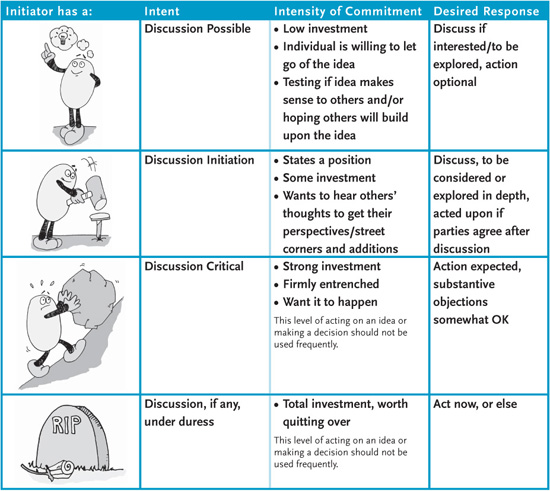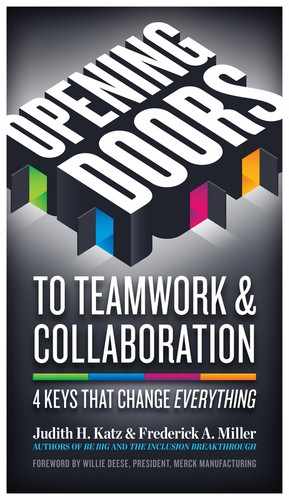Opening the Door to … …. UNDERSTANDING
Key #3: State Your Intent and Intensity

CORE BEHAVIORS TO UNDERSTANDING
State Your Intent and Intensity
Share whether your statement is a
![]() NOTION: an initial idea
NOTION: an initial idea
![]() STAKE: an idea you’re committed to, but can be moved
STAKE: an idea you’re committed to, but can be moved
![]() BOULDER: an item requiring action, with little room for negotiation
BOULDER: an item requiring action, with little room for negotiation
![]() TOMBSTONE: a nonnegotiable position (Act or else!)
TOMBSTONE: a nonnegotiable position (Act or else!)
In other words,
I say what I mean
and how much I mean it.

This seems so elementary
When I say what I mean, it eliminates guesswork. When I make people guess my Intent, there is a strong possibility they will guess wrong—which guarantees that effort, resources, and time will be wasted. When I clearly state what I mean and how committed I am to the idea or thought, others are better able to act quickly, decisively, and correctly. By clearly disclosing our objectives and intentions so others fully understand our Intent and Intensity, it makes it easier for us to achieve Right First Time interactions.
This enables everyone to calibrate how much to invest in a discussion, when to contribute ideas, and when to move to action. This makes life and work much easier for all of us!
The key to opening the
door to understanding is
to create clarity about
our Intent and Intensity.

I am midway to completion of a high-priority project when George, a senior leader, walks by and asks how things are going.
When I tell him what I am working on, he smiles, leans closer, and says, “That is interesting! Have you thought about this?” He mentions an idea my team had already explored but decided would be more expensive and time-consuming than the approach we adopted.
Before I can find a diplomatic way to reply, George says, “You know, our Asian office is working on a similar program. You might want to check out what they are doing.”
Then he looks at his watch, shakes his head, and says, “Late for a meeting. Got to go. Nice talking with you.” And he is gone.
So now what do I do?
Do I call my team together and tell them we need to go back and take the slower, more expensive approach?
Did his comments constitute a career-dependent Go Do?
At XYZ Company, People Count
Several groups of senior leaders were visiting one of their company’s production sites. As part of making conversation with one of the local managers, one of the visiting leaders offhandedly remarked, “I wonder how many valves there are at this site?”
That night, a team stayed up all night to count all the valves.
It certainly was not the leader’s intent to have people engage in this behavior; the question was just a passing comment. But without explicit clarity about Intent and Intensity (i.e., the leader’s intent regarding having someone provide a response to the thought), an idle question turned into an action that wasted a lot of people’s time and energy.
All Thoughts, Suggestions, and Ideas Are Not Created Equal
In our work with organizations around the world, we have noticed a common problem among CEOs, middle managers, individual contributors, and frontline team members: None of them is a mind reader or telepath. None of them can tell exactly how their words and ideas are being interpreted by others. None of them can be certain whether or how their meanings and intentions have been heard or understood without conversation.
Sometimes a leader or a team member will make a statement to stimulate debate and discussion. It might be a spur-of-the-moment idea, or it could be something the person has been chewing on for a while and wants to share with others and to hear what they think.
Sometimes a leader will share something with such intensity and passion that it might sound like a directive, when in reality, the leader was just excited about the idea and did not intend anyone to act on it automatically or without a great deal more discussion or direction.
Sometimes people will make a calm, quiet statement that is reflective of something they feel strongly about, and which is intended as a clear directive with a call for action and execution that is not open for discussion.
Without extrasensory abilities or a commitment to regular use of a common language to clarify the Intent and Intensity of statements like these, misinterpretations and missteps are inevitable.
Without Understanding, Waste Is Inevitable
Without a means for clarifying the true intent and intensity of our communications, we run the risk of creating distractions, diluting our messages, and even sabotaging our intended outcomes. If people don’t understand whether our comments are up-to-you suggestions or must-do directions for actions they need to take, a lot of time and energy is wasted.
The door to understanding won’t open …
![]() if you don’t know my expectations and I don’t know yours.
if you don’t know my expectations and I don’t know yours.
![]() if I don’t know how strongly committed you are to the idea you just shared.
if I don’t know how strongly committed you are to the idea you just shared.
![]() if I don’t know whether a remark was intended as something just to think about, something to respond to and build upon, or something that is nonnegotiable and requiring immediate and specific action.
if I don’t know whether a remark was intended as something just to think about, something to respond to and build upon, or something that is nonnegotiable and requiring immediate and specific action.
THE COMMON PROBLEM OF “DRIVE-BY” COMMUNICATIONS
Our focus on clarifying people’s intentions and their levels of commitment to their intentions grew out of hearing people talking about how their leaders would constantly change the scope of their projects with “drive-by” comments and suggestions.
Our solution: a means to quickly, simply, and surely communicate and understand the nature and priority of a statement. That was the origin of
NOTIONS
STAKES
BOULDERS
and
TOMBSTONES
NOTIONS are statements that don’t require any action from others.
A Notion is an in-the-shower idea or a hallway thought, offered as an invitation for further discussion. It is just a Notion—something that has not been given much thought and that does not have a lot of vested interest attached to it.
When a leader makes a casual statement such as “Maybe we should look into cloud computing for the office,” or “Wouldn’t it be great if we could all rotate jobs one day each month,” it could easily become an action item unless prefaced by the phrase, “Here’s a Notion” or “This is just a Notion.”
Without that additional clarification, the team could easily interpret the comments as, “We better look into cloud computing,” or “We should establish a jobrotation schedule.” And that could mean a great deal of unexpected, unintended, and wasted effort.
A Notion is an invitation to have a discussion. By positioning a statement as a Notion, we open the door to exploring the idea and seeing where it will take the group. The pathway and outcome are not predetermined but rather open for joint discovery.
STAKES express a firmer position on an idea or issue.
Like the stakes we put into the ground to stabilize a tent, Stakes establish a place for the potential solution or discussion to start—but that place is intended to be moveable.
Imagine someone in a planning meeting saying, “We need to open a new distribution center in the Southwest. We should build it in Albuquerque.” That could be interpreted as a demand to start building in Albuquerque and reorganizing, depending on how people hear implications of the statement.
But a different discussion follows if that person says, “We need to do something about distribution in the Southwest. My Stake is we build a new distribution center in Albuquerque.”
That opens the door to a discussion that might include a new distribution center in Albuquerque as a solution to the distribution issues but also might turn to other possibilities such as leasing a larger fleet of trucks, expanding distribution centers in Colorado and Texas, or pulling out of the Southwest market.
Saying, “Here is my Stake on this issue …” opens the door to understanding by …
![]() clarifying your current position on the idea or issue based on the current facts and reasoning available to you.
clarifying your current position on the idea or issue based on the current facts and reasoning available to you.
![]() inviting others to supply additional sets of facts and alternative lines of reasoning with a goal of arriving at the optimum assessment of the issue and the best decision possible.
inviting others to supply additional sets of facts and alternative lines of reasoning with a goal of arriving at the optimum assessment of the issue and the best decision possible.
Although you have set a Stake, you are inviting others to join you in determining the best possible location for that Stake.
When you put your Stake in the ground and demonstrate that you are willing, eager, and able to move it, you are saying that no one of us is smarter than all of us, and that others may have insights and information that might reveal a better position for that Stake.
There is an implied belief that by stimulating others to respond to your Stake, it will enhance the idea: the wisdom of all of us involved will emerge, and the idea will be better than when it started.
BOULDERS offer little wiggle room.
Unlike a Stake, a Boulder is an item requiring action—a high priority. Someone who makes a Boulder statement has a strong investment in seeing the idea addressed in the way she or he has framed it. While a Boulder is not an invitation to discussion, requests for clarification and suggestions for implementation strategies might be accepted and even appreciated.
When you say, “This is a Boulder for me …” it implies that a considerable amount of energy and very persuasive information will be required by others to change your position and the direction of your desired decision and action. Boulders can be moved, but not easily!
Warning: Boulder statements should not be made with great frequency since that suggests there is little openness to being influenced or to change the decision, and the impact may be that team members stop bringing their thinking or opinions to the table.
TOMBSTONES mean “this issue is not negotiable.”
A Tombstone also means “You can have my badge over this one,” “Forget about any discussion,” or “Over my dead body!” When you label a statement a Tombstone, it indicates your total commitment to the idea or issue—so much so that you may be willing to leave your job if the action is not carried out or if you are asked to do something you are absolutely not willing to do. Often, Tombstones are about core values or beliefs, and to take or not take the action would violate your integrity and sense of who you are. Sometimes a Tombstone is an edict from above. The message is “just do it” and there is no sense in people spending time in discussion. In general, Tombstone statements should be made only in critical situations, when personal or organizational integrity is at issue.
Guide to Notions, Stakes, Boulders, & Tombstones

Adapted from the original article “Notions, Stakes, Boulders, and Tombstones” © 2007, 2011 written by Fredrick A. Miller, The Kaleel Jamison Consulting Group, Inc. All rights reserved. No duplication without written consent. 518.271.7000. www.kjcg.com.
Abdul’s Badge
When Ingrid was on leave, her company went through a reorganization process in which her position was identified for elimination. The leader in charge of the reorganization instructed Abdul, Ingrid’s manager, to notify her that her job was being eliminated.
Abdul refused, saying it was a Tombstone for him. It violated his personal code of ethics to eliminate her job while she was out on leave when there had been a commitment that she would have a job when she returned. He also felt it was a betrayal of the company’s values.
The leader appreciated Abdul’s candor and his desire to defend the values of the company. He worked with Abdul to reassign Ingrid temporarily to a new but comparable position and then support her in her transition.
“This Is Just a Notion…”
One of the reasons some people in organizations turn into yes-women or yes-men is their inability to distinguish the Intent and Intensity of team leaders’ statements.
They may be afraid to offer their different perspectives because they fear the sender’s statement is really a Boulder or Tombstone—a statement that cannot be easily discussed or influenced—when, in fact, it might just be a Stake or even a Notion expressed with passion.
That is why when you preface an in-the-shower idea or a hallway thought with a clear statement of Intent and Intensity, it doesn’t just prevent misunderstandings; it can also stimulate greater participation in discussions. Conversely, if you intend a statement to be a Boulder or Tombstone, but you are not explicit about your Intent and Intensity (i.e., you did not use the words Boulder or Tombstone), there can be unwanted pushback and a lack of responsiveness, which can result in key deadlines and opportunities being missed.
Whether you are a leader or a team member, if you fail to share your opinion or expertise, your knowledge will be missing from the conversation. This results in wasted effort, false starts, and extra time spent redoing tasks, all of which suboptimize the talents of every team member, including the team leader.
Too much of anything can cause problems, and one of the benefits of defining Intent and Intensity in terms of Notions, Stakes, Boulders, and Tombstones is that we can begin to notice how frequently we tend to use each of them. While expressing Notions can be a great tool for opening the door to creativity and innovation, too many Notions can lead to a lack of decisive action. On the other hand, too many Tombstones result in the death of new thinking and energy for innovation.
Opening the Door to Understanding Yourself
Before I can make my Intent and Intensity clear to others, I must first be clear about them to myself. Asking “What are my intentions in making this statement?” often yields valuable insights. I may realize I have not considered what my intentions are or how strongly I feel about a given idea or perspective.
Making a habit out of clarifying Intent and Intensity helps you take greater ownership of your ideas and also reduces confusion.
So What’s Stopping You from Wanting to State Your Intent and Intensity?
“I want to see what kind of reaction I get
before I commit. If the boss doesn’t like my
idea, I don’t want to be tied to it.”
“Isn’t it obvious what I mean? If they are
not sure what I mean, they should ask me.
I can’t help it if they are afraid to ask.”
“I feel awkward. I am not used to stating my
intentions. We don’t talk that way around here.”
![]() Taking responsibility for our own ideas and statements can require us to Lean into Discomfort. If you are afraid your boss will criticize your idea—or you for having raised it—it might help to let the boss know that in order to share it you will need to Lean into Discomfort. Then, if she is willing to Listen as an Ally, she will understand and appreciate your Notions or Stakes.
Taking responsibility for our own ideas and statements can require us to Lean into Discomfort. If you are afraid your boss will criticize your idea—or you for having raised it—it might help to let the boss know that in order to share it you will need to Lean into Discomfort. Then, if she is willing to Listen as an Ally, she will understand and appreciate your Notions or Stakes.
![]() It is common not to take the extra time to clarify meanings, intentions, and priorities that you believe ought to be obvious. And often it is hard to ask others what they really mean. But the extra time and effort eliminates waste and missteps in the long run.
It is common not to take the extra time to clarify meanings, intentions, and priorities that you believe ought to be obvious. And often it is hard to ask others what they really mean. But the extra time and effort eliminates waste and missteps in the long run.
![]() When we disclose our intentions, we do more than simply reduce the possibility of misunderstanding and make the act of listening easier. We also offer an invitation to others to reciprocate and disclose their intentions, which promotes cooperation, collaboration, and a greater sense of safety for us all. It might be awkward at first, but that’s another reason why the first key, Lean into Discomfort, is so important.
When we disclose our intentions, we do more than simply reduce the possibility of misunderstanding and make the act of listening easier. We also offer an invitation to others to reciprocate and disclose their intentions, which promotes cooperation, collaboration, and a greater sense of safety for us all. It might be awkward at first, but that’s another reason why the first key, Lean into Discomfort, is so important.
A Boulder with Some Stakes
A team was working on its strategic plan at an off-site meeting. Wei Choong, the team leader, started the meeting by saying, “Here’s my Boulder: We are going to increase our production by 30% within the next 18 months. If you agree or disagree, I need to hear that now.”
After a very brief discussion, everyone agreed that they would fully support the direction and time frame. They were aware that additional discussion would only waste valuable time since Wei Choong’s mind was firmly made up!
With the goals defined, it was time to discuss their implementation plans. Wei Choong had spent quite some time thinking about ways the team might approach achieving the production goal, but she believed the team could offer valuable contributions to the plan. In opening that phase of the discussion, she said, “Here are my Stakes—which I am willing to move—and here are some of my Notions…”
The team had a very engaged discussion, at the end of which they had agreement and ownership on their path forward. With clarity about the leader’s and each other’s Intent and Intensity, they opened the door to understanding, which yielded alignment among team members and a clear path forward.
Checklist for Stating Intent and Intensity
![]() Make Notions, Stakes, Boulders, and Tombstones common language for how the team will engage.
Make Notions, Stakes, Boulders, and Tombstones common language for how the team will engage.
![]() Clarify that your passion on a topic does not mean you are closed to hearing other perspectives. Let people know that your Stakes and Notions, even when stated passionately, are still just Stakes and Notions.
Clarify that your passion on a topic does not mean you are closed to hearing other perspectives. Let people know that your Stakes and Notions, even when stated passionately, are still just Stakes and Notions.
![]() Actively seek feedback from team members on how often you use the range of Intent and Intensity. (Too many Notions and Stakes can be distracting. Too many Boulders or Tombstones can be dispiriting.)
Actively seek feedback from team members on how often you use the range of Intent and Intensity. (Too many Notions and Stakes can be distracting. Too many Boulders or Tombstones can be dispiriting.)
![]() Lean into Discomfort, Listen as an Ally, and hear others’ Street Corners to fully engage the team for greater understanding.
Lean into Discomfort, Listen as an Ally, and hear others’ Street Corners to fully engage the team for greater understanding.





